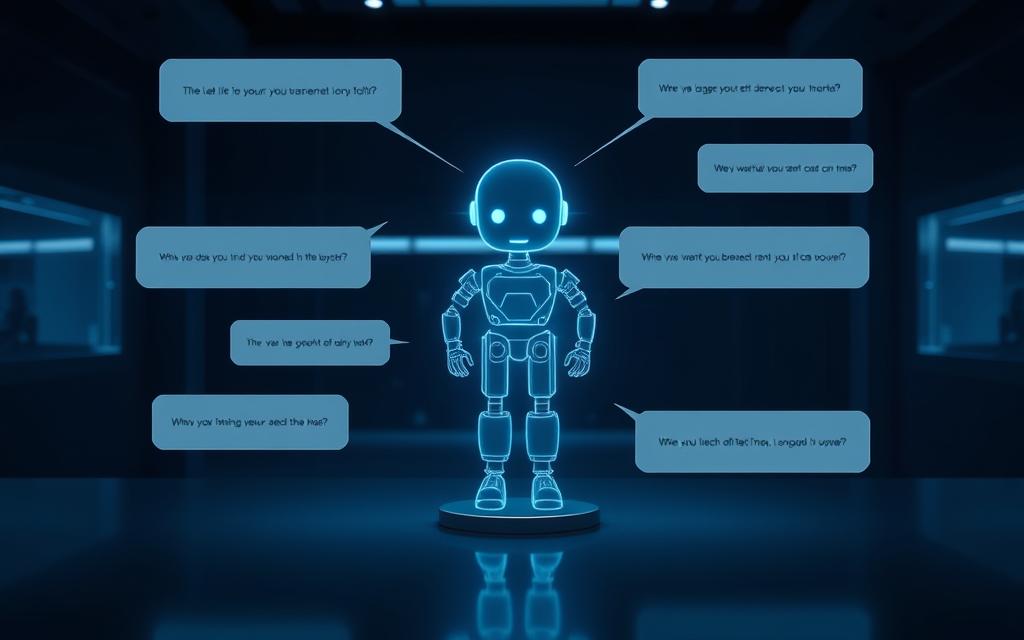Modern artificial intelligence has changed how we use technology. These advanced systems are a big step up from old search engines.
The International Baccalaureate Organisation says these tools can talk like humans. They respond to questions in a way that’s different from regular search engines.
These systems use natural language processing (NLP) to get and give answers. This makes them better at understanding and answering questions than older systems.
But, even the best chatbot systems have their limits. Knowing what they can and can’t do is key to using them well.
Understanding the AI Question Answerer
Artificial intelligence question answering systems are a big step in modern computing. They change how we use digital information. These systems use advanced tech to understand and answer our questions in natural language.
What Constitutes an AI Question Answerer
An AI question answerer has many parts working together. At the heart is natural language processing. This lets the system understand our questions, not just match keywords.
It also uses big knowledge bases to find answers. Microsoft calls this “a conversational layer over data.” This mix of understanding and finding info is key for a digital assistant.
Machine learning makes these systems better over time. They learn from past chats and get more accurate and aware. This makes them more useful.
Historical Evolution and Technological Progress
Question answering systems have changed a lot over time. Early ones just matched patterns and had small databases. They gave simple, not very helpful answers.
The International Baccalaureate Organisation found big improvements in AI tools in 2023. This is thanks to better neural networks, more computing power, and bigger datasets.
Now, systems use deep learning to understand context and give human-like answers. This is a big step forward in tech.
Practical Applications in Everyday Life
AI question answerers have many uses in real life. They help customer service answer common questions fast and cheaply.
Schools use them to help students right away. These systems can explain things, give homework help, and point to resources. They help teachers too.
Companies make their own conversational AI apps for their needs. They use cloud services and their own knowledge bases. This makes digital assistants that know their business.
Smartphones and smart devices have personal digital assistants. They help with planning, finding info, and managing tasks. They make our lives easier with voice commands.
How an AI Question Answerer Processes Information
An AI question answerer uses a two-stage process to give smart answers. It starts by understanding human language and ends by finding answers in vast information databases.
Analysing User Queries with Natural Language Processing
The first step is natural language processing (NLP). This technology lets machines understand text or voice inputs very well.
Tokenisation and Semantic Parsing Techniques
Tokenisation breaks down queries into smaller parts called tokens. These tokens are words, phrases, or characters. The system then looks at these tokens to understand grammar and relationships.
Semantic parsing goes deeper. It looks at how words connect to form meaningful ideas. This helps the AI understand the real meaning behind words.
Contextual Understanding and Intent Recognition
Advanced systems use contextual analysis to understand the conversation. They look at past interactions, user preferences, and the situation. This makes their answers more relevant.
Intent recognition is the final step. The system figures out what the user really wants. Whether it’s information, a task, or clarification, the AI knows the user’s goal.
“The service trains on content to create a knowledge base of QnA pairs, inferring relationships from structured and semi-structured content.”
Leveraging Knowledge Bases and Data Sources
After understanding the query, the system searches for answers. It uses various information sources through advanced retrieval methods.
Integration with Large Language Models like GPT-4
Modern systems use powerful language models like GPT-4. These models understand language deeply and can mix information from different sources into clear answers.
The success of these systems depends on how clear the input is. As Question AI reviews show, better input leads to better answers.
Accessing Structured Databases and Unstructured Text
AI systems use both organised databases and unstructured text. Organised databases have precise, verified information. Unstructured text, like articles, needs deeper analysis.
The system checks information from many sources to ensure accuracy. This approach helps give detailed answers that cover all parts of the user’s question. It makes sure answers are up-to-date and reliable.
The Mechanism Behind Response Generation
Exploring AI question answering systems shows a complex mix of training methods and model designs. This mix turns raw data into clear, relevant answers we see every day.
Training Methodologies and Model Architectures
Today’s AI question answerers use many learning methods. These methods shape how systems process and create answers.
Supervised Learning and Reinforcement Learning Approaches
Most AI systems start with supervised learning. This method uses labelled data to teach models the right answers. They learn by seeing many examples.
Reinforcement learning is different. It gives feedback on how good the answers are, not just if they’re right or wrong. This helps systems get better through trial and error.
Many systems use both methods. They learn the basics with supervised learning and then get better with reinforcement learning. This mix often leads to better results.
Transformer models changed how we understand language. They use attention mechanisms to grasp context and word relationships better than before.
BERT is great at understanding language context. It looks at text from both sides, catching subtleties that others might miss. This makes it excellent at comprehension tasks.
T5 sees all NLP tasks as text-to-text problems. It can handle many tasks, from translation to answering questions. Its flexibility helps it perform well across different types of questions.
Transformer models are key to today’s response generation systems. Their design lets them handle complex questions and understand context well.
| Training Approach | Primary Function | Strengths | Limitations |
|---|---|---|---|
| Supervised Learning | Pattern recognition from labelled data | High accuracy with clear examples | Requires extensive labelled datasets |
| Reinforcement Learning | Optimisation through feedback | Adapts to nuanced contexts | Can develop unexpected behaviours |
| Transformer Architectures | Contextual understanding | Excellent language comprehension | Computationally intensive |
Formulating and Delivering Answers
Creating answers that are correct, useful, and relevant is key. This requires balancing accuracy, clarity, and context.
Ensuring Coherence and Relevance in Outputs
Keeping answers coherent is a big challenge for AI. The text must flow well and stay on topic. Systems use special algorithms for this.
Checking if answers match the question is also important. This ensures answers are relevant. It helps avoid off-topic responses.
“The true measure of AI response quality lies not in factual accuracy alone, but in the seamless integration of correctness, context, and clarity.”
Today’s systems have many checks during response generation. Each check looks at different aspects of quality. This makes their outputs more reliable.
Handling Ambiguity and Multi-part Questions
Dealing with unclear questions is tough. Systems must figure out unclear questions and provide the best answer. This needs good context understanding.
Handling complex, multi-part questions is even harder. Systems must break down questions, answer each part, and then combine answers. As the question AI review shows, this is a big challenge.
Advanced models use special techniques for complex questions. They might break questions into smaller parts, answer each, and then combine answers. Yet, dealing with complex questions is an area that’s always improving.
Limitations of AI Question Answerer Systems
AI question answering systems are very useful but have big limits. These limits affect how reliable their answers are and the ethics of using them.
Issues with Accuracy and Factual Reliability
One big worry is that AI sometimes gives wrong answers. These answers might sound right but are actually wrong.
Challenges of Hallucinations and Misinformation
AI hallucinations happen when systems make up information that seems real but isn’t. This is a big problem with AI limitations today.
Microsoft’s Transparency Note warns against using these systems in risky situations:
“Avoid high-risk scenarios like healthcare due to the risk of dangerous wrong information. The system is not a substitute for professional judgment.”
Impact of Biased or Incomplete Training Data
The quality of AI answers depends on the data it’s trained on. The International Baccalaureate Organization says biased data leads to biased answers. It’s important to check these answers carefully.
People need to check AI answers for accuracy and bias in AI. If the data is incomplete, the answers might be outdated or missing important information.
Ethical and Operational Constraints
AI question answerers also face big ethical challenges. These challenges affect how useful and trustworthy they are.
Cultural and Linguistic Biases in Responses
AI systems often show biases from their training data. This can mean their answers might not be fair or might not understand certain questions.
They can struggle with different languages and dialects. These hallucinations and biases need careful thought when using AI worldwide.
Privacy Risks and Data Handling Concerns
AI systems often get sensitive information from users. This raises big data privacy worries. How companies handle this data is a major concern.
Many systems keep a record of conversations to improve. But this can be risky. Users should know what happens to their questions and if humans might see them.
These AI limitations show we should see AI as tools, not the only answer. Knowing their limits helps us use AI wisely.
Conclusion
AI question answerers are big steps in technology. They understand and answer our questions using smart algorithms. These systems have changed how we find information in many areas.
Their abilities are growing as machine learning and data handling get better. This makes them more useful to us.
But, we need to use AI responsibly. It’s important to know what these tools can and can’t do. We should always think critically about the answers they give.
AI can sometimes give wrong or biased answers. This is why we must be careful.
The International Baccalaureate Organisation says AI is best for helping with research, not replacing human thinking. This shows how vital it is to use AI wisely. We should use these tools while keeping our values and honesty intact.

















